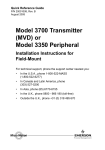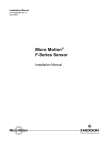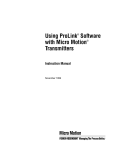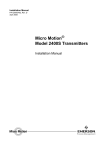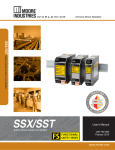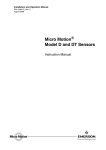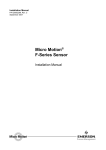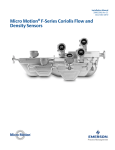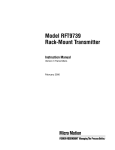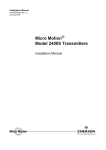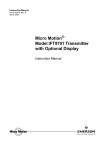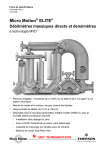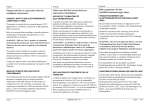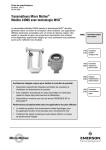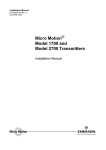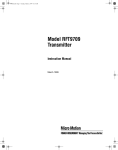Download ProLink II Quick Reference Guide
Transcript
Quick Reference Guide P/N 20001908, Rev. GA August 2009 ProLink® II Installation and Startup For customer service, phone the support center nearest you: • In the U.S.A., phone 800-522-MASS (800-522-6277) (toll-free) • In Canada and Latin America, phone +1 303-527-5200 • In Asia: • - In Japan, phone 3 5769-6803 - In other locations, phone +65 6777-8211 (Singapore) In Europe: - In the U.K., phone 0870 240 1978 (toll-free) - In other locations, phone +31 (0) 318 495 555 (The Netherlands) Customers outside the U.S.A. can also send an email to Micro Motion customer service at: [email protected] BEFORE YOU BEGIN About these instructions This quick reference guide explains basic installation guidelines for Micro Motion® ProLink® II software. For complete instructions about installation and use, refer to the ProLink II manual. WARNING An improper connection between ProLink II and the transmitter can cause an explosion. To avoid causing an explosion, be sure to connect ProLink II to the transmitter using safe methods. To avoid causing an explosion: • Do not open a non-intrinsically safe wiring compartment in a hazardous area. • Do not use the computer running ProLink II in a hazardous area. Note: If you have a Model 2700 transmitter with transmitter software earlier than v3.4, and you have the concentration measurement application installed, you cannot access the concentration measurement functions with ProLink II v2.1 or later. Contact Micro Motion for alternative solutions. ©2009, Micro Motion, Inc. All rights reserved. ELITE, ProLink, and the Micro Motion logo are registered trademarks of Micro Motion, Inc., Boulder, Colorado. MVD and MVD Direct Connect are trademarks of Micro Motion., Inc., Boulder, Colorado. Micro Motion is a registered trade name of Micro Motion, Inc., Boulder, Colorado. The Emerson logo is a trademark of Emerson Electric Co. All other trademarks are property of their respective owners. 1 PC requirements To install and run ProLink II, your PC must meet or exceed the following requirements: • 200 MHz Pentium processor • One of the following: - Windows XP with Service Pack 1 and 128MB RAM - Windows 2000 with Service Pack 3 and 128MB RAM • 80MB of available hard disk space • Video with support for 256 or more colors • CD-ROM Drive • An available serial port or USB port Installation kits Micro Motion provides ProLink II installation kits for the following connection types: • RS-485 to serial port (RS-232) • RS-485 to USB port • Bell 202 to serial port (RS-232) • Bell 202 to USB port The installation kits include signal converters and assorted adapters, cables, and testers. If you need a ProLink II installation kit, contact Micro Motion. Note: If you do not use a signal converter supplied by Micro Motion, it is your responsibility to ensure that your equipment provides equivalent functionality. See the ReadMe.txt file in the ProLink II installation directory, or contact Micro Motion customer support for assistance or additional information. Note: A Windows driver is required for correct operation of the Bell 202 USB signal converter. This driver is provided with the installation kit. Ensure that the driver is installed before attempting to connect through the USB port. If this driver is not installed, Windows will not recognize the USB converter when it is plugged into the USB port. 2 STEP 1. Install the ProLink II software To install ProLink II software: 1. Insert the ProLink II CD-ROM into the PC’s CD-ROM drive. 2. If the setup program does not start automatically, locate and run the SETUP.EXE file. The file is located in the root directory on the CD-ROM (e.g., D:\setup.exe, where “D” is your CD-ROM drive letter). Note: The user who installs the ProLink II software must have permission to write to the registry. 3. Follow the on-screen instructions to complete the installation. If you have a previous version of ProLink II installed on your PC, you may be prompted to remove it before installing the new version. Warning: The ProLink II site key is associated with a specific disk drive and specific folder on your PC. If you decide to move ProLink II after installation, you will have to transfer the license and reinstall ProLink II. To avoid this step, be sure to install ProLink II into a location that you can use permanently. 4. Follow the on-screen instructions to generate the temporary license. This license will allow you to run ProLink II with full functionality for seven days, starting from the current date and time. 5. A site key is required for a permanent license. Follow the instructions in the ProLink II manual to obtain and configure a site key. Warning: The temporary license will expire after seven days, and ProLink II will not connect to a transmitter. Be sure to configure the site key before the temporary license expires. In typical installations, the manual is installed with the ProLink II program, and can be opened from the Micro Motion folder in the Windows Start menu. You can also find the ProLink II manual on the installation CD, in the root directory. Note: Adobe Acrobat Reader is required to read the ProLink II manual. The self-extracting setup file for this program is provided in the root directory of the ProLink II installation CD, if Acrobat Reader is not already installed on your system. The ProLink II setup program does not install Acrobat Reader automatically. 3 STEP 2. Connect the PC to the transmitter 1. Connect the appropriate signal converter to your PC’s serial or USB port, using adapters as required. • For connections using the Bell 202 physical layer, use the Bell 202–RS-232 signal converter. • For connections using the RS-485 physical layer, use the RS-485–RS-232 signal converter. 2. Connect the two leads of the signal converter to the appropriate terminals on your transmitter. See Table 1. Table 1. Transmitter terminals for ProLink II connections Terminals for connection type HART/ Bell 202 Transmitter PV+ PV– IFT9701/9703 4-20 + 4-20 – RFT9712 17 HART/ RS-485 A B 16 21 22 Modbus/ RS-485 A B D22 Service port A B 8 7 RFT9739 • Rack-mount Z30 D30 Z22 D22 Z22 • Field-mount 17 18 27 26 27 26 • Model 1700/2700 with analog outputs LFT field-mount with output option codes 1, 3 1 2 5 6 5 6 Model 1700/2700 with intrinsically safe outputs(1) 1 2 8 7 • 1 2 8 7 8 7 8 7 • • • • Model 2700 with configurable input/ outputs LFT field-mount with output option code 4 Model 2700 with FOUNDATION™ fieldbus LFT field-mount with output option code 6 Model 2700 with PROFIBUS-PA Model 2200S HART clips 4 Table 1. Transmitter terminals for ProLink II connections (Continued) Terminals for connection type HART/ Bell 202 Transmitter PV+ Model 2400S with analog outputs 1 2 or HART clips HART/ RS-485 PV– A B Modbus/ RS-485 A B Service port A B Service port clips Model 2400S with DeviceNet Service port clips Model 2400S with PROFIBUS-DP Service port clips Series 3000 • Panel-mount with solder-tail or screwtype connectors c2 a2 c32 a32 c32 a32 c32 a32 • Panel-mount with I/O cables 14 15 24 25 24 25 24 25 • Rack-mount c2 a2 c32 a32 c32 a32 c32 a32 • Field-mount 2 1 11 12 11 12 11 12 • • Model 1500/2500 LFT DIN rail with output option codes 2, 5, 8 21 22 33 34 33 34 Model 7826/7828(2) 3 4 Model 7829(2) 3 4 Model 7835/7845/7846/7847(2) 11 12 Model 7835 EXD(2) 3 4 MVD™ Direct Connect™ with no barrier(3) 3 4 MVD Direct Connect with MVD™ Direct Connect™ I.S. barrier • Connection to barrier(4) 13 14 • Connection to core processor(3) 3 4 3 4 Core processor(3)(5) (1) If connecting to terminals 1 and 2, terminals must be externally powered, with a minimum of 250 Ω and 17.5 volts. Requirement does not apply to service port. (2) Transmitter version with advanced electronics option only. (3) Connection is not intrinsically safe. (4) Intrinsically safe connection. 5 (5) Connecting directly to the core processor terminals is supported for sensor-mounted core processors (4-wire remote installations) or stand-alone core processors (remote core processor with remote transmitter installations). 3. Add resistance if required. Many HART connections require added resistance. See Table 2. For additional information, see the ProLink II manual or the transmitter manual. Table 2. Added resistance for ProLink II connections Resistance range for connection type Transmitter HART/ Bell 202 HART/ RS-485(1) Modbus/ RS-485(1) IFT9701/9703 250–600 Ω RFT9712 250–1000 Ω (1) Rack-mount 250–1000 Ω (1) (1) Field-mount 250–1000 Ω (1) (1) Model 1700/2700 with analog outputs LFT field-mount with output option codes 1, 3 250–600 Ω (1) (1) Service port RFT9739 • • • • (1) Model 1700/2700 with intrinsically safe outputs 250–600 Ω (1) • 250–600 Ω (1) • • • Model 2700 with configurable input/outputs LFT field-mount with output option code 4 (1) Model 2700 with FOUNDATION fieldbus LFT field-mount with output option code 6 (1) Model 2700 with PROFIBUS-PA Model 2200S 250–600 Ω Model 2400S with analog outputs 250–600 Ω (1) Model 2400S with DeviceNet (1) Model 2400S with PROFIBUS-DP (1) Series 3000 250–600 Ω (1) 6 (1) Table 2. Added resistance for ProLink II connections (Continued) Resistance range for connection type HART/ Bell 202 Transmitter • • Model 1500/2500 LFT DIN rail with output option codes 2, 5, 8 HART/ RS-485(1) 250–600 Ω Modbus/ RS-485(1) Service port (1) Model 7826/7828(2) (1) MVD Direct Connect (1) (1) RS-485 connections may require added resistance if the connection is long-distance or if there is external noise that interferes with the signal. Add two 120-Ω resistors in parallel with the output, one at each end of the communication segment. (2) Transmitter version with advanced electronics option only. 4. For Modbus network connections, ensure that ProLink II is the only Modbus master currently active on the network. There are additional methods for connecting ProLink II to your transmitter, including connecting over a network. See the ProLink II manual for complete information. STEP 3. Configure the connection and connect To connect to a Model 7826 or Model 7828 (transmitter versions only): 1. Start ProLink II software. 2. In the Connection menu, click Connect to Densitometer/Viscometer. 3. Set Serial Port to the PC COM port you are using to connect to the device. 4. If you know the address of the device and you want to communicate with this product only: a. Enter the address in the From Address and To Address fields. b. Click Connect. 5. If you do not know the address, or if you want to communicate with multiple devices: a. Enter an address range in the From Address and To Address fields. b. Click Connect. 7 ProLink II will poll all addresses in the specified range, and populate the Found dropdown list with all Model 7826/7828 devices found in that range. When polling is complete, select the desired address from the Found dropdown list and use other ProLink II windows to work with the associated device. To interact with a different device, return to the Connection window and select the address of the new device. 6. If ProLink II fails to connect: • Try adding resistance to the connection. See Table 2. • Swap the leads and try again. • Ensure that ProLink II is the only Modbus master currently active on the network. To connect to all other transmitters: 1. Start ProLink II software. 2. In the Connection menu, click Connect to Device. 3. Use the Protocol parameter to specify your connection type. For HART/Bell 202 connections using the converter supplied by Micro Motion, enable Converter Toggles RTS. 4. Set Serial Port to the PC COM port you are using to connect to the transmitter. 5. Specify additional communication parameters. • If you are making a service port or HART/Bell 202 connection, default values are used for all remaining communication parameters. No configuration is required. • If you are connecting to an MVD Direct Connect system, set the remaining communication parameters to any of the supported values listed in Table 3. The core processor auto-detects incoming communications settings and switches to match. 8 • • If you are connecting to any Model 2400S transmitter using the service port: - For point-to-point connections, you can use a service port connection type. - For multidrop network connections, you can use any RS-485 connection type and specify the transmitter’s Modbus address. The transmitter auto-detects incoming communications settings and switches to match. The service port autodetection limits are described in Table 4. For all other connection types: - Default values for Series 1000/2000/3000 transmitters and LF meters are listed in Table 5. - Default values for RFT97xx and IFT97xx transmitters are listed in Table 6. If your transmitter is not using default values, refer to site documentation for the values you are using. - Default values for density and viscosity meters are listed in Table 7. Note: ProLink II automatically sets data bits appropriately for the configured protocol. Even though a data bits parameter may be configured in the transmitter, you do not need to configure it in ProLink II. HART protocol is always 8 data bits. If your transmitter is configured for Modbus with 7 data bits, specify Modbus ASCII; if your transmitter is configured for Modbus with 8 data bits, specify Modbus RTU. Table 3. MVD Direct Connect auto-detection limits Parameter Option Protocol Modbus RTU (8-bit) Modbus ASCII (7-bit) Baud rate Standard rates from 1200 to 38,400 Parity Even, odd, none Stop bits 1, 2 9 Table 4. Model 2400S service port auto-detection limits Parameter Option Protocol Modbus RTU (8-bit) Modbus ASCII (7-bit) Address Responds to both: • Service port address (111) • Configured Modbus address (default=1) Baud rate Standard rates from 1200 to 38,400 Stop bits 0, 1 Parity Even, odd, none Table 5. Default communication values for Series 1000/2000/3000 transmitters and LF meters Default values Transmitter Physical layer Protocol Baud Stop bits Parity Address • Model 1500/2500 LFT DIN rail Bell 202(1) HART 1200 1 odd 0 RS-485(2) Modbus RTU 9600 1 odd 1 Model 1700/2700 LFT fieldmount Bell 202(1) HART 1200 1 odd 0 RS-485(2)(3) HART 1200 1 odd 0 Model 2200S Bell 202(4) HART 1200 1 odd 0 • • • RS-485(5) Model 2400S with analog outputs Bell 202(1) HART 1200 1 odd 0 RS-485(6) Modbus (RTU or ASCII) Autodetect Autodetect Autodetect 1 Series 3000 Bell 202(1) HART 1200 1 odd 0 RS-485(2) Modbus RTU 9600 1 odd 1 (1) Connection to primary mA output, or to HART clips if available. (2) Connection to RS-485 terminals. (3) Available only on Model 1700/2700 transmitters with analog outputs or LF transmitters with output option codes 1 or 3. (4) Connection to HART clips. (5) Connection to RS-485 terminals. (6) Connection to service port. 10 Table 6. Default communication values for RFT97xx and IFT97xx transmitters Default values Transmitter Physical layer Protocol Baud Stop bits Parity Address IFT9701/ IFT9703(1) Bell 202(2) HART 1200 1 odd 0 RFT9712 Bell 202(2) HART 1200 1 odd 0 RS-485(3) HART 1200 1 odd 0 Bell 202(2) HART 1200 1 odd 0 RS-485(3) HART 1200 1 odd 0 Bell 202(2) HART 1200 1 odd 0 RFT9739 v2 RFT9739 v3 RS-485(3)(4) • Std. comm Modbus RTU 9600 1 odd 1 • User defined HART 1200 1 odd 0 (1) IFT9701/9703 communication parameters are not configurable. The settings shown here are always in effect. (2) Connection to primary mA output. (3) Connection to RS-485 terminals. (4) Dip switch settings on the transmitter are used to select either Std. comm or User defined. Table 7. Default communication values for density and viscosity meters Default values Transmitter Physical layer Protocol Baud Stop bits Parity Address Model 7826/28 RS-485(1) Modbus RTU 9600 2 none 1 Model 7829 RS-485(1) Modbus RTU 9600 2 none 1 Model 7835/7845/78 46/7847 RS-485(1) Modbus RTU 9600 2 none 1 Model 7835 EXD RS-485(1) Modbus RTU 9600 2 none 1 (1) Connection to RS-485 terminals. 6. Click the Connect button. ProLink II will attempt to make the connection. • If you are making a service port connection to a Model 1700/2700, Model 2400S, LFT field-mount, or Model 2200S transmitter, you can make the connection at any time. 11 • If you are connecting to a Model 1500/2500, Series 3000, or LFT DIN rail mount transmitter, the RS-485 terminals are available in service port mode for 10 seconds after transmitter power-up. - If a service port connection is made during this interval, the terminals will remain in service port mode until the next power cycle, and you can make a service port connection at any time. - If no connection is made during this interval, the terminals switch to RS-485 mode and you can make an RS-485 connection at any time. If the terminals are in one mode and you want to use the other mode, you must power cycle the transmitter to reset the mode, then make the appropriate connection at the appropriate time. • If you are using any other connection type, you can make the connection at any time. 7. If ProLink II fails to connect: • Try adding resistance to the connection. See Table 2, the ProLink II manual, or the transmitter manual. • For Modbus connections, swap the leads and try again. • For Modbus connections, ensure that ProLink II is the only Modbus master currently active on the network. • If you are using Modbus ASCII protocol to connect to the Model 2400S transmitter with analog outputs, ensure that Modbus ASCII support is enabled on your transmitter. • For HART connections to Model 1700/2700 transmitters with the intrinsically safe outputs option board, ensure that the terminals are externally powered. • For HART connections to the USB port: • - Ensure that you have checked the box labeled Converter Toggles RTS in the ProLink II Connect window. - Ensure that the required Windows driver is installed on your PC. If this driver is not installed, Windows will not recognize the USB converter when it is plugged into the USB port. For additional troubleshooting suggestions, see the ProLink II manual. 12 13 14 ©2009, Micro Motion, Inc. All rights reserved. P/N 20001908, Rev. GA *20001908* Visit us on the Internet at www.micromotion.com Micro Motion Inc. USA Worldwide Headquarters 7070 Winchester Circle Boulder, Colorado 80301 T +1 303-527-5200 +1 800-522-6277 F +1 303-530-8459 Micro Motion Europe Micro Motion Asia Emerson Process Management Neonstraat 1 6718 WX Ede The Netherlands T +31 (0) 318 495 555 F +31 (0) 318 495 556 Emerson Process Management 1 Pandan Crescent Singapore 128461 Republic of Singapore T +65 6777-8211 F +65 6770-8003 Micro Motion United Kingdom Micro Motion Japan Emerson Process Management Limited Horsfield Way Bredbury Industrial Estate Stockport SK6 2SU U.K. T +44 0870 240 1978 F +44 0800 966 181 Emerson Process Management 1-2-5, Higashi Shinagawa Shinagawa-ku Tokyo 140-0002 Japan T +81 3 5769-6803 F +81 3 5769-6843
















